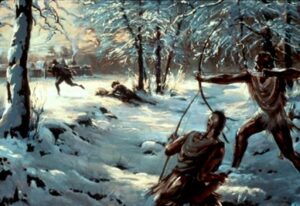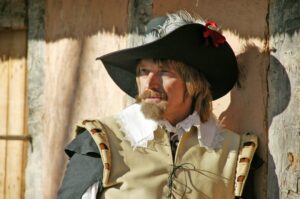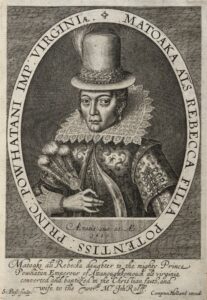Just two years after the establishment of Jamestown, English colonists found themselves embroiled in a struggle against the powerful Powhatan Chiefdom, the Algonquian-speaking group in control of Virginia’s coastal region.
Article by Henricus Historical Park Staff
1609-1614- Virginia: First Anglo-Powhatan War
This war, the First Anglo-Powhatan War, threatened the very existence of the Virginia colony and tested the resolve of English colonizers. It marked the first major American war fought by the English, the first of three wars against the Powhatan, and the first of many British military campaigns against Indian people in North America.
A variety of tensions ignited the First Anglo-Powhatan War, but the advent of war centered around the main issues of food, trade, and the control of land. The English colonists came ill-prepared for survival in Virginia and relied heavily on the Powhatan for sustenance in the first two years. Drought and harsh winters, however, limited the supply the Powhatan could reasonably share—all while other tensions further soured relations. As the Powhatan became increasingly suspicious of colonists’ designs to stay in the region and expand into their lands, they traded less willing and frequently, forcing the English to act more aggressively to procure food. Angering the native population through heavy-handed trading tactics and challenging Powhatan sovereignty and safety in their own land, the English provoked a military response in the autumn of 1609.
The war began disastrously for the English. After a few small armed conflicts on opposite ends of the James River, the Powhatans decisively ambushed an English party under John Ratcliffe in October 1609 before besieging Jamestown. Powhatan tactics quickly bore fruit as many settlers starved in the winter of 1609 and 1610 (later remembered as the “Starving Time”), and the colony teetered on the brink of collapse. Unable to trade or grow food beyond the confines of the small fort, the English seemed doomed to starve. In summer 1610, Jamestown’s leaders prepared to vacate the colony altogether, but the arrival of Lord De La Warr’s supply fleet saved the colony and reinvigorated the English war effort.
 With fresh men and supplies, the English viciously counterattacked in 1610 and 1611. Settlers lashed out at nearby Powhatan settlements by conducting lightning raids with the assistance of their fast-moving and seemingly unassailable ships. Utilizing military tactics perfected in the pacification of Ireland in the late sixteenth century, the English aimed to starve and scare the Powhatan into submission by razing down fields, towns, and killing women and children during these raids. New leaders, like Sir Thomas Gates and Sir Thomas Dale, further brought the war to the Powhatan and enforced harsh military discipline on their men. Dale’s arrival in 1611 signified a major turning point in the war. A competent military officer with experience in the Netherlands and Ireland, Dale’s strategic thinking and brutal campaigning began the process of breaking Powhatan’s power over the region. Dale and his troops quickly subdued enemy tribes around Jamestown before establishing a strategically vital settlement at Henricus near the Falls of the James River. From Henricus, Dale launched several expeditions that defeated the Appamattocks, a powerful tribe within Powhatan’s chiefdom, and gave the English the military initiative.
With fresh men and supplies, the English viciously counterattacked in 1610 and 1611. Settlers lashed out at nearby Powhatan settlements by conducting lightning raids with the assistance of their fast-moving and seemingly unassailable ships. Utilizing military tactics perfected in the pacification of Ireland in the late sixteenth century, the English aimed to starve and scare the Powhatan into submission by razing down fields, towns, and killing women and children during these raids. New leaders, like Sir Thomas Gates and Sir Thomas Dale, further brought the war to the Powhatan and enforced harsh military discipline on their men. Dale’s arrival in 1611 signified a major turning point in the war. A competent military officer with experience in the Netherlands and Ireland, Dale’s strategic thinking and brutal campaigning began the process of breaking Powhatan’s power over the region. Dale and his troops quickly subdued enemy tribes around Jamestown before establishing a strategically vital settlement at Henricus near the Falls of the James River. From Henricus, Dale launched several expeditions that defeated the Appamattocks, a powerful tribe within Powhatan’s chiefdom, and gave the English the military initiative.
Increasingly hemmed in by English forces and worried about other Indian polities to the west and north, Chief Powhatan found himself in an unenviable position. With his military power and authority diminished, he lacked the inclination and resources to go on an all-out offensive. The war thus entered a bit of a stalemate.  Even after the capture of one of his daughters (the famed Pocahontas) in 1613, Powhatan delayed responding to the English for many months and largely rebuffed attempts to use his daughter as a bargaining chip. It was still Pocahontas, however, that helped bring the war to an end. Her conversion to Christianity and marriage to John Rolfe in spring 1614 sealed an uneasy peace between the two peoples. In the end, the Virginia colony survived the ordeal of war, and the lull in hostilities allowed the English to rapidly expand their presence in the ensuing decade.
Even after the capture of one of his daughters (the famed Pocahontas) in 1613, Powhatan delayed responding to the English for many months and largely rebuffed attempts to use his daughter as a bargaining chip. It was still Pocahontas, however, that helped bring the war to an end. Her conversion to Christianity and marriage to John Rolfe in spring 1614 sealed an uneasy peace between the two peoples. In the end, the Virginia colony survived the ordeal of war, and the lull in hostilities allowed the English to rapidly expand their presence in the ensuing decade.
